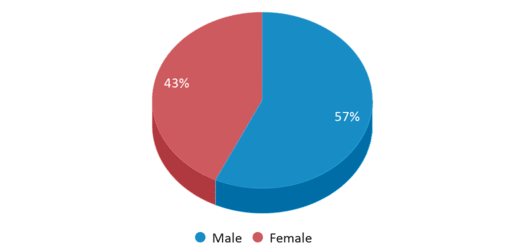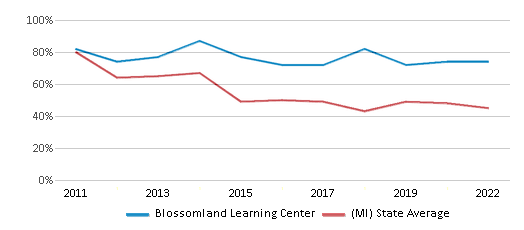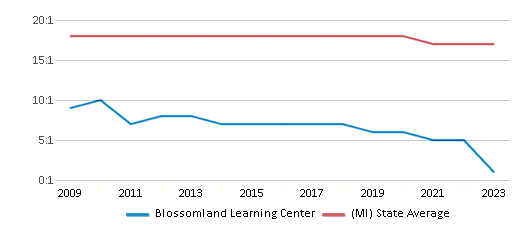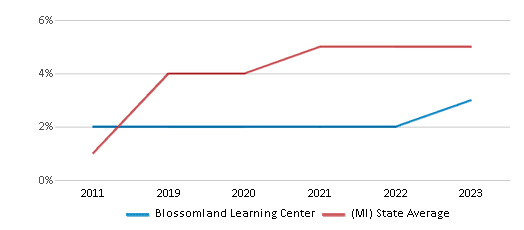Serving 138 students in grades Prekindergarten-12, Blossomland Learning Center ranks in the top 5% of all schools in Michigan for overall test scores (math proficiency is top 10%, and reading proficiency is top 10%).
The percentage of students achieving proficiency in math is 60-69% (which is higher than the Michigan state average of 34%). The percentage of students achieving proficiency in reading/language arts is 70-79% (which is higher than the Michigan state average of 45%).
The student:teacher ratio of 6:1 is lower than the Michigan state level of 17:1.
Minority enrollment is 41% of the student body (majority Black), which is higher than the Michigan state average of 37% (majority Black).
Quick Stats (2025)
- School Type: Special education school
- Grades: Prekindergarten-12
- Enrollment: 138 students
- Student:Teacher Ratio: 6:1
- Minority Enrollment: 41%
- Graduation Rate: <50%
- Overall Testing Rank: Top 5% in MI
- Math Proficiency: 60-69% (Top 10%)
- Reading Proficiency: 70-79% (Top 5%)
- Science Proficiency: ≥80% (Top 1%)
- Source: National Center for Education Statistics (NCES), MI Dept. of Education
Top Rankings
Blossomland Learning Center ranks among the top 20% of public schools in Michigan for:
Category
Attribute
Overall Rank
Math Proficiency
Reading/Language Arts Proficiency
Science Proficiency
Community Size
Student Attention
School Overview
Blossomland Learning Center's student population of 138 students has declined by 8% over five school years.
The teacher population of 25 teachers has stayed relatively flat over five school years.
School Type
Grades Offered
Grades Prekindergarten-12
Total Students
138 students

Gender %

Total Classroom Teachers
25 teachers

Students by Grade

School Rankings
Blossomland Learning Center ranks within the top 5% of all 3,069 schools in Michigan (based off of combined math and reading proficiency testing data).
The diversity score of Blossomland Learning Center is 0.55, which is less than the diversity score at state average of 0.56. The school's diversity has stayed relatively flat over five school years.
Overall Testing Rank
#135 out of 3069 schools
(Top 5%)
(Top 5%)

Math Test Scores (% Proficient)
60-69%
34%

Reading/Language Arts Test Scores (% Proficient)
70-79%
45%

Science Test Scores (% Proficient)
≥80%
38%

Student : Teacher Ratio
6:1
17:1

American Indian
n/a
1%
Asian
1%
4%

Hispanic
4%
9%

Black
32%
18%

White
59%
63%

Hawaiian
n/a
n/a
Two or more races
4%
5%

All Ethnic Groups



Graduation Rate
(17-18)<50%
85%

Participates in the National School Lunch Program (NSLP)
Yes
Eligible for Free Lunch
67%
50%

Eligible for Reduced Lunch
6%
4%

School Statewide Testing
School District Name
Source: National Center for Education Statistics (NCES), MI Dept. of Education
Profile last updated: 02/09/2025
Frequently Asked Questions
What is Blossomland Learning Center's ranking?
Blossomland Learning Center is ranked #135 out of 3,069 schools, which ranks it among the top 5% of public schools in Michigan.
What schools are Blossomland Learning Center often compared to?
Blossomland Learning Centeris often viewed alongside schools like Sanilac Isd Special Education Services, Pathway School by visitors of our site.
What percent of students have achieved state testing proficiency in math and reading?
60-69% of students have achieved math proficiency (compared to the 34% MI state average), while 70-79% of students have achieved reading proficiency (compared to the 45% MI state average).
What is the graduation rate of Blossomland Learning Center?
The graduation rate of Blossomland Learning Center is 50%, which is lower than the Michigan state average of 85%.
How many students attend Blossomland Learning Center?
138 students attend Blossomland Learning Center.
What is the racial composition of the student body?
59% of Blossomland Learning Center students are White, 32% of students are Black, 4% of students are Hispanic, 4% of students are Two or more races, and 1% of students are Asian.
What is the student:teacher ratio of Blossomland Learning Center?
Blossomland Learning Center has a student ration of 6:1, which is lower than the Michigan state average of 17:1.
What grades does Blossomland Learning Center offer ?
Blossomland Learning Center offers enrollment in grades Prekindergarten-12
What school district is Blossomland Learning Center part of?
Blossomland Learning Center is part of Berrien RESA School District.
In what neighborhood is Blossomland Learning Center located?
Blossomland Learning Center is located in the Oronoko charter Township neighborhood of Berrien Springs, MI. There are 4 other public schools located in Oronoko charter Township.
School Reviews
5 9/22/2006
MY GRANDDAUGHTER ATTENDS BLOSSOMLAND LEARNING CENTER. HER NAME IS NAUTICA ALLEN. NAUTICA IS 8 YEARS OLD AND SHE IS NOT QUITE POTTY TRAINED AND SHE DOES NOT TALK. WHEN SHE BEGAN SCHOOL AT BLOSSOMLAND 3 YEARS AGO SHE WAS NOT POTTY TRAINED AT ALL AND SHE DID NOT SPEAK AT ALL. SINCE ENROLLING AT BLOSSOMLAND SHE HAS RECEIVED PHYSICAL THERAPY, OCCUPATIONAL THERAPY, SPEECH THERAPY MUSIC THERAPY AND SWIMMING THERAPY . THESE THERAPIES HAVE REALLY HELPED NAUTICA.SHE IS SAYING SOME WORDS NOW AND HAS LEARNED SOME SIGN LANGUAGE. SHE IS ALMOST POTTY TRAINED THANKS TO HER TEACHER AND HER TEACHERS AIDE. I WOULD LIKE TO THANK BLOSSOMLAND FOR BEING THERE FOR NAUTICA. THERE IS NO WAY THAT SHE COULD HAVE PROGRESSED SO MUCH IN A NORMAL SCHOOL SETTING.
Review Blossomland Learning Center. Reviews should be a few sentences in length. Please include any comments on:
- Quality of academic programs, teachers, and facilities
- Availability of music, art, sports and other extracurricular activities
Recent Articles

What Is A Charter School?
Explore the world of charter schools in this comprehensive guide. Learn about their history, how they operate, and the pros and cons of this educational innovation. Discover key facts about charter schools, including admission policies, demographics, and funding, as well as what to look for when considering a charter school for your child.

10 Reasons Why High School Sports Benefit Students
Discover the 10 compelling reasons why high school sports are beneficial for students. This comprehensive article explores how athletics enhance academic performance, foster personal growth, and develop crucial life skills. From improved fitness and time management to leadership development and community representation, learn why participating in high school sports can be a game-changer for students' overall success and well-being.

February 05, 2025
Understanding the U.S. Department of Education: Structure, Impact, and EvolutionWe explore how the Department of Education shapes American education, from its cabinet-level leadership to its impact on millions of students, written for general audiences seeking clarity on this vital institution.





